There is a popular assertion on the Internet that cancer is less common among Muslims, and they fight it (supposedly very effectively) by abstaining from food for several days. We decided to check whether this is supported by statistical and scientific data.
In a viral text reported (spelling and punctuation preserved): “A disease such as cancer in Muslim countries is not considered a dangerous disease and is easily treated within a few days with fasting. But in Russia, huge amounts of money are being made from this disease, but the methods of treatment are not made public. The fact is that Muslims call this disease not cancer, but a beast that absorbs several times more energy than ordinary cells of the body. It multiplies and multiplies (metastasizes), and then, when it multiplies and lacks energy, it eventually consumes all the body's resources, followed by death. And when the animal is deprived of food, it quickly dies. Professors at the University of Algeria say that cancer dies during fasting from 3 days to a month, and at any stage. Fasting means not eating anything and drinking only clean water. As soon as hard black feces come out of a person naturally, it means the disease has passed.” Next, the author talks about the benefits of eating fruit on an empty stomach, and at the end he encourages you to forward the text to ten people.
Some sites, publics And bloggers illustrate the statement about the rarity of cancer in Muslim countries graphs and statistics, and also note the beneficial effects of fasting during the Muslim holy month of Ramadan. This connection between Islam and a reduced likelihood of getting cancer is discussed in publications on the IslamNews website, and on the islam-today website posted an interview with academic Leonid Kitayev-Smyk, who argues that low cancer rates in Muslim countries are explained by cultural characteristics, in particular wearing the hijab.
The verified text began to spread across the Russian-language segment of social networks in 2019. Then its origin got interested popularizer of science, Doctor of Physical and Mathematical Sciences Semyon Yesilevsky. He noticed that the text consists of two slightly unrelated fragments: about cancer and fasting in Muslim countries and about a certain Dr. Stephen Mack, who recommends eating fruit on an empty stomach for the treatment and prevention of many diseases, including cancer. Yesilevsky almost does not analyze the first part of the text, only noting that there is no evidence of the effectiveness of fasting for the treatment of cancer. This fragment, unlike the second, is written without obvious grammatical errors. The section on the benefits of fruits, as Esilevsky notes, was created using low-quality machine translation from English - for example, this is how “gray hair” appeared in the text instead of “gray hair.” The original English text mentioning Dr. Mack appeared no later than 2010 and was distributed via email. How found out Skeptic's Dictionary project, in the earliest versions of the mailing list its author calls Mac "a friend I met in a Bible class." Later, an unknown compiler combined a story about a Protestant activist and reflections on the increased immunity of residents of Muslim countries to cancer.
Is it true that cancer is less common in Muslim countries?
Let's first deal with the statement that people in Muslim countries are supposedly less likely to get cancer. The most recent summary country-by-country statistics from the World Cancer Research Fund at the time of writing dated 2022 Considering that the viral text appeared no later than 2019, it will be quite relevant to verify its veracity. According to these data, Denmark had the first place in the number of cancer patients in 2022 (334.9 per 100,000 inhabitants), followed by Ireland, Belgium, Hungary, France, the Netherlands, Australia, Norway, New Caledonia and Slovenia. That is, among the countries in the top ten, there really is not a single one where the Muslim population predominates. The first such state on the list is located only in 50th position - this is Türkiye (225.6 per 100,000 people). The bottom of the ranking is largely Muslim countries; in the last ten are Sudan, South Sudan, Djibouti, Tajikistan, Gambia and Niger (76.4 per 100 thousand).
It would seem that these data already confirm the first part of the statement being verified. However, such a conclusion would be hasty. Let's take five of the most common types of cancer: neoplasms of various nature in the lungs (12.4% of all cancer diagnoses in the world), breast cancer (BC; 11.5%), colorectal cancer (9.6%), prostate cancer (7.3%) and stomach cancer (4.6%). By data National Cancer Institute (USA), the median age of diagnosis of lung cancer (that is, in half of the patients the disease was detected earlier, and in half - later) is 71 years, breast cancer - 62 years, colorectal cancer - 67 years, prostate cancer - 66 years, cancer stomach - 68 years old.
At the same time, life expectancy, for example, in Niger amounts to only 53 years for women and 52 for men. The share of the population over 65 years of age is also extremely low - only 2%. That is, the country is in last place in the number of cancer patients simply because the majority of its residents simply do not live to see cancer. In Gambia the proportion of elderly is the same, in Tajikistan it is slightly higher - 3%.
This hypothesis is supported by data on the prevalence of cancer types by country. Thus, in Niger, breast cancer is in first place, which generally does not stand out from global statistics, but in second place is liver cancer, which is not even among the top five most common in the world. This is a disease typical for people over 60 years of age, but people with hepatitis C usually develop it at age 30 or older. According to different estimates (medicine is not very well developed in Niger, which makes it difficult to obtain accurate data), up to 7% of the country's population suffers from hepatitis, therefore, they are predisposed to the early development of liver cancer. The prevalence of cervical and ovarian cancer also stands out from global statistics (5.4% and 4.8% of all cancer patients, respectively). The main cause of cervical cancer is the human papillomavirus (HPV), its oncogenic strains are responsible for the development of this type of cancer in 95% of cases. WHO emphasizesThat the fight against HPV, and therefore the prevalence of cervical cancer, is particularly acute in sub-Saharan Africa is due to “inequalities in access to vaccination, screening and treatment services, risk factors including HIV prevalence, and social and economic factors such as gender, gender bias and poverty.”
However, if we analyze data from the most prosperous countries with a predominant Muslim population (Saudi Arabia, UAE) and compare them with predominantly Christian ones (Poland and Croatia), the picture changes. As a selection criterion, closeness in life expectancy was chosen (OPZH) and human development index (HDI), which the World Cancer Research Fund refers to one of the most important predictors of cancer incidence.
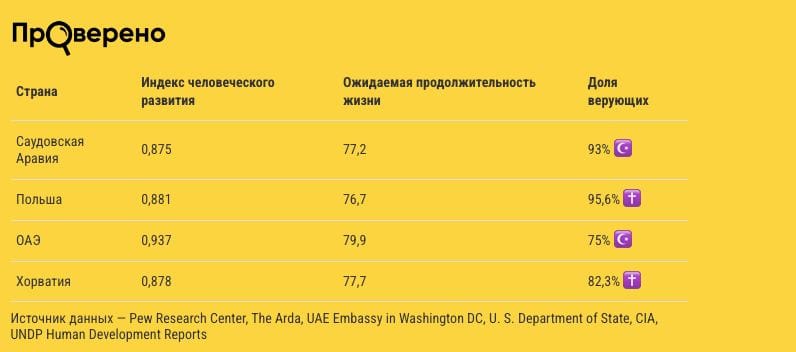
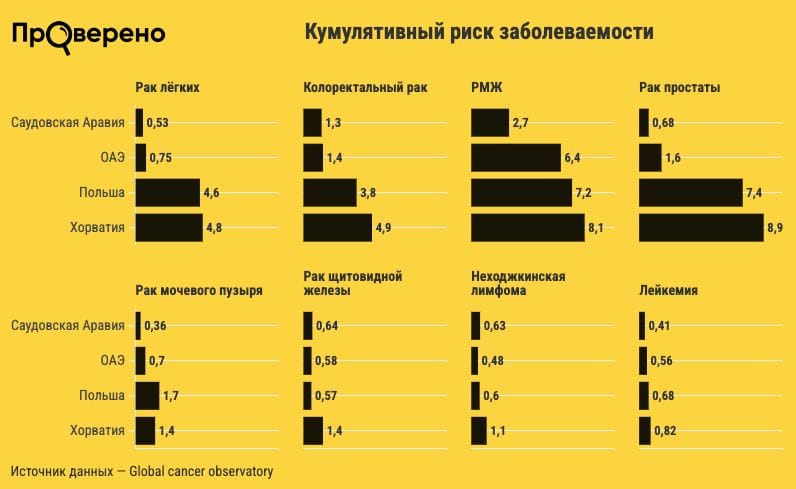
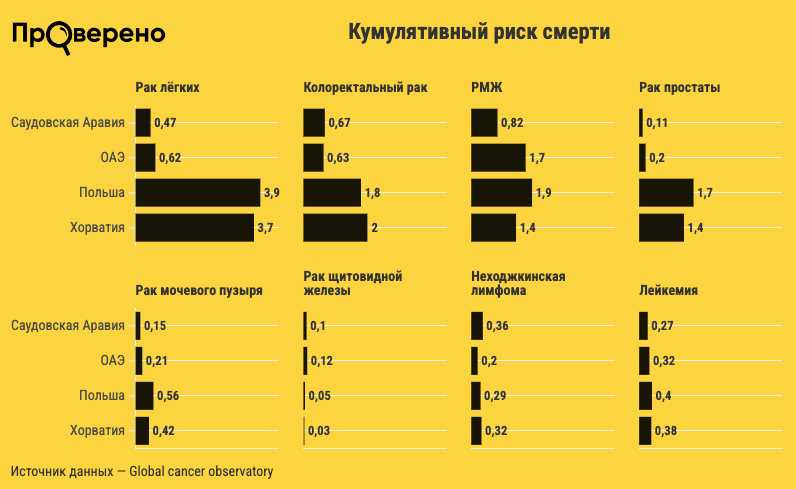
At first glance, the data seems to support the idea that cancer is significantly less common in Muslim countries. However, these statistics do not take into account an extremely important parameter - the median age of the population. As mentioned above, the risk of cancer increases with age. Median age in Saudi Arabia is 32.4 years, in the UAE - 35.8, in Poland - 42.9, in Croatia - 45.1. That is, the analyzed Christian countries are, on average, noticeably older than Muslim ones. You can also look at what percentage of the population is in each country older 65 years old: if in Saudi Arabia there are only 3% of such residents, and in the UAE - 2%, then in Poland - 19%, in Croatia - 22%.
Demographic characteristics are also reflected in the prevalence of different types of cancer. Thus, the top five most “popular” types of cancer in Saudi Arabia and the UAE include leukemia and non-Hodgkin’s lymphoma - they are much “younger” than lung, breast, prostate, intestinal and stomach cancer. Among leukemias allocate five types, one of which usually occurs in very young people (median age 20 years), two are characteristic of patients aged about 50 years. Among the types of non-Hodgkin's lymphomas also There is those that mainly affect young people.
Let's test this hypothesis on another sample. Let's find a country in which there are as few elderly people as in Saudi Arabia and the UAE, but the vast majority of the population are Christians (unfortunately, it will not be possible to select such a hypothetical country to also have a high level of HDI). Thus, in the Central African Republic (CAR; 89% population - Christians) share of the population over 65 years of age amounts to 3%, and per 100,000 people there are 99.2 cancer patients (for comparison, in Saudi Arabia - 95.2, in the UAE - 104.8). At the same time, according to the Human Development Index (0.385), the Central African Republic is more than two times behind these wealthy Middle Eastern monarchies. There is simply no country with a significant predominance of the Muslim population and a proportion of people over 65 years of age comparable to Poland and Croatia; the oldest Muslim country is Turkey, where 9% of people over 65 live there (that is, about half as much as in Poland or Croatia) and 225.6 out of 100,000 suffer from cancer. In Poland, this figure is 260.4, and in Croatia - 284.1. A similar proportion of elderly people as in Turkey - in Panama (more 80% of the population professes Christianity), only the prevalence of cancer there is almost two times lower - 148.2.
It is also possible to look beyond the dichotomy of Islam and Christianity. In Nepal share people over 65 years of age is 6% (twice as much as in Saudi Arabia, and three times as much as in the UAE), but it is recorded there total 80 cancer cases per 100,000 inhabitants. In Japan share people over 65 years of age - 30%, and the prevalence of cancer amounts to 282.9 per 100,000.
It turns out that formally the statement that there are fewer cancer patients in Muslim countries is relatively true, but the reason is not at all due to the particularly healthy lifestyle associated with the religion of these people. It's all about the composition of the population - in Muslim countries there are more children, youth and middle-aged people, while in Christian countries there is a significant proportion of the elderly population. Since cancer is more common among older people, there will be more people diagnosed with cancer in such countries.
Is it true that cancer is “easy to treat” in Muslim countries?
Let's now look at the second part of the statement - supposedly cancer in predominantly Muslim countries is not considered a serious disease and is easily treatable. Important a statistical parameter in assessing the severity of the disease is five-year survival rate, that is, the proportion of patients who, five years after diagnosis or initiation of treatment, survived and at least stopped the progression of the disease. For example, a five-year survival rate of 80% means that out of 100 people with a similar clinical picture, 80 survived five years later. For a specific patient, this indicator is not always accurate, but for the country as a whole it is very indicative.
In the case of cancer, additional parameters must be taken into account for a correct comparison. One of them is the stage at which the cancer was detected. The difficulty is that there are several protocols to determine it, which are not always possible to compare. For example, in the UK and Russia the three-parameter TNM scale is used, and in the USA the five-parameter SEER is used. In addition to them, their own metrics are used for some specific types of cancer: colorectal cancer get their bearings on the Duke’s scale (it is based on four parameters), for gynecological oncological diseases a three-factor scale is used scale FIGO, and for prostate tumors - scale Gleason based on assessment of the degree of differentiation.
Also on the forecast of five-year survival influences, from what type of cells the tumor appeared and in what part of the organ it is located, how much the cancer cells differ from normal ones (in the scientific literature this parameter is called the degree of differentiation), the gender and age of the patient.
This number of additional parameters seriously limits the possibilities for conducting comparative studies. Rare exception - statistics, collected by the International Agency for Research on Cancer. It takes into account the stage of the disease with conversion between two main scales (TNM and SEER), the gender and age of the patients, and also (for some types of cancer) the type of cells from which the tumor arose. However, this work reflects data from only six countries, and none of them are predominantly Muslim.
Other data sets take into account many fewer parameters. For example, in the report, prepared The non-profit organization "Commonwealth Fund" calculated survival rates for breast cancer without adjusting for stage, age or degree of differentiation. The researchers used data from 20 countries, none of them with a majority Muslim population.
Chinese scientists analyzed five-year survival rate for patients with lung cancer, based on statistics from different countries that were collected in the second half of the 2000s. The sample does not include Saudi Arabia or the UAE, but other predominantly Muslim countries include Kuwait (16.3% of patients lived longer than five years), Qatar (13.2%), Malaysia (10.1%), Turkey (14.9%) and Libya (2.6%). These figures are by no means the highest. For comparison, in Japan the five-year survival rate for lung cancer was 32.9%, in Mauritius (about half of the residents profess Hinduism, about a third are Christian) - 31.7%, in Australia - 21.4%, in Switzerland, Norway and Latvia - 20.4%. However, there is a significant gap in this work - the authors do not indicate for what stage and type of cancer these data are relevant.
Similar methodological shortcomings exist in statistics, collected by the International Agency for Research on Cancer. It analyzed five-year survival rates for 15 types of cancer, but also did not adjust for stage. This parameter can seriously affect the quality of the analysis: if a country has good screening and many diseases are detected at an early stage, then treatment will be effective and many patients will live a long time, even if they later die due to cancer. Conversely, if early detection is low, then doctors will find cancer when the patient is unlikely to overcome the five-year mark.
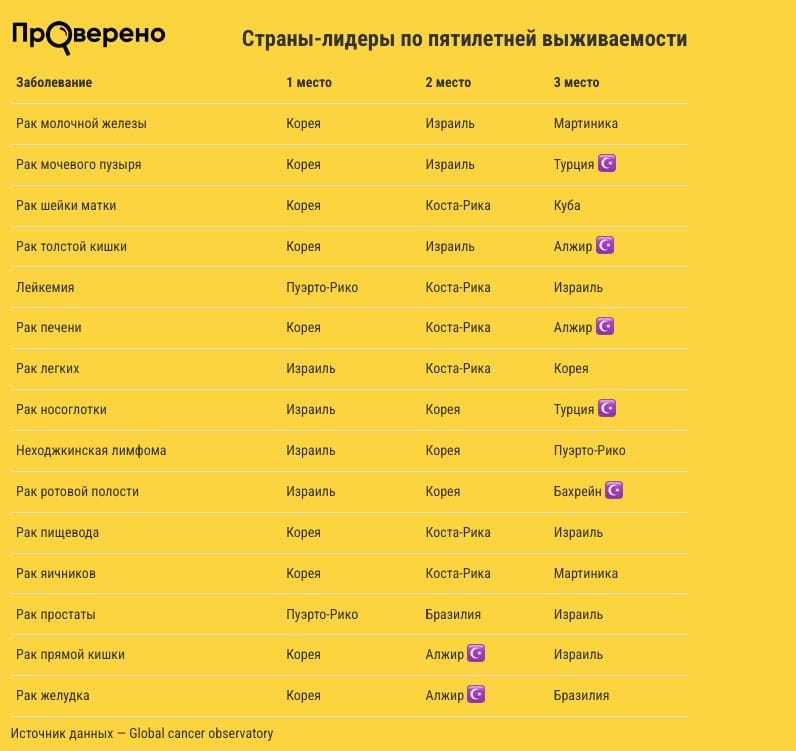
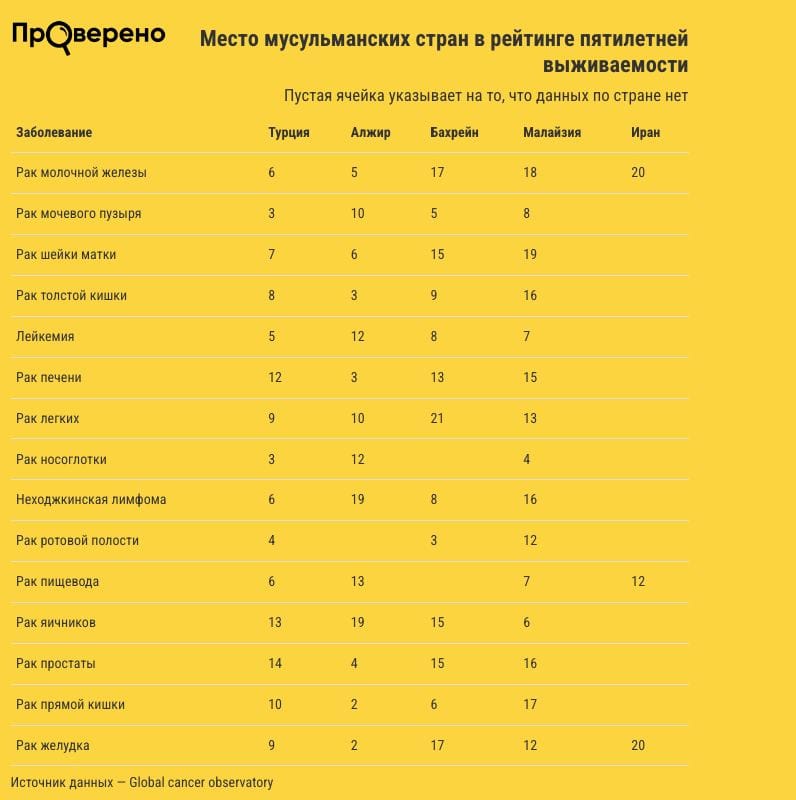
As the table shows, for none of the types of cancer analyzed, the country with a predominantly Muslim population does not lead in five-year survival rate. In terms of survival rate for seven types of cancer out of the 15 analyzed, this state is among the top three. The best prognosis for most types of cancer is in patients from Korea, where, according to data for 2023, 51% of the population does not identify itself with any religion, 31% of residents profess Christianity, another 17% - Buddhism.
The DALY (Disability-Adjusted Life Years) parameter is also used to assess the damage that cancer causes to people. Roughly speaking, he shows, how many years of life the disease took from a particular patient. Residents of Sri Lanka (the majority of the population are Buddhists), Saudi Arabia, Oman, Syria and Algeria are losing just under two years. In the UAE, cancer “loses” 3.2 years, in Pakistan and Afghanistan - more than 4. For comparison, residents of Croatia “lose” 3.7 years, Poland - a little more than 4, Switzerland and Japan - 2.5 each, India and Bangladesh - 2.2 each. That is, there is no direct connection between the dominant religion and disability or premature death from cancer.
Thus, statistics do not confirm that in Muslim countries cancer is treated better and people die less from cancer. Although global data is incomplete, no fewer people die from cancer in Muslim countries than in countries with a different religion or no religion.
Is it true that cancer can be cured by fasting?
Finally, let's deal with the last statement: cancer is supposedly easily cured by fasting. Not a single cell of the body can exist without glucose supplied with food - the main source of energy. The process of breaking down this substance and obtaining energy from it for cellular metabolism is called glycolysis. Cancer cells also need glucose, but the glycolysis they carry out is different from normal - it is happening about 200 times more active.
Modern scientific development aimed specifically at "ban" fast glycolysisso that cancer cells “starve” and die. Most of these experiments are now at the stage of laboratory testing in cell culture or animals. It is still premature to talk about the proven effectiveness and safety of this treatment method. Fasting in the everyday sense cannot “prohibit” rapid glycolysis, and cancer cells in the absence of glucose capable “switch” to nutrition with uridine molecules, which play a decisive role in the synthesis of RNA, glycogen and cell biomembranes.
And although fasting will not cure, there are some positive effects for cancer patients from temporarily abstaining from eating. A review by Chinese researchers notes that not eating 24 or even 48 hours before starting chemotherapy reduced the frequency and severity of side effects such as headache, nausea, vomiting and diarrhea. American scientists have found that a low-calorie diet increases effectiveness of chemotherapy for breast cancer in mice. Also regular night abstinence from food for 13 hours reduced the likelihood of breast cancer recurrence in women who have had it.
In addition, intermittent fasting can be one of the ways to combat excess weight, the presence of which applies to predisposing factors for the development of a number of oncological diseases. How show Research has shown that this method of losing weight helps you lose slightly more weight than giving up “junk” food, but primarily due to the reduction of muscle rather than fat tissue.
At the same time, there are contraindications to fasting for cancer patients. Firstly, this is cancer cachexia - a decrease in the mass of adipose tissue and skeletal muscle. Depending on the location of the tumor, from 13% to 61% of patients suffer from such a complication. Secondly, fasting is strictly prohibited in case of sarcopenia - loss of muscle mass and decreased muscle function. Her prevalence even higher - from 38% to 70%, for lung cancer - up to 79%, and for pancreatic cancer - up to 89%.
Thus, it is impossible to get rid of cancer solely by fasting. Moreover, cancer cells are more “omnivorous” and can feed on more than just glucose. However, fasting helps to tolerate chemotherapy more easily and even increases its effectiveness. At the same time, not all cancer patients can fast; such common complications as cachexia and sarcopenia are contraindications for abstaining from food.
Update dated May 22, 2024: A fragment has been added to the beginning of the analysis, which describes the history of the appearance of the viral text. The previous version can be found at link.
We thank demographer Alexey Raksha for his assistance in preparing the article.
Cover image: Image by Mohamed Hassan from Pixabay
If you find a spelling or grammatical error, please let us know by highlighting the error text and clicking Ctrl+Enter.






